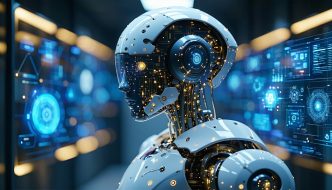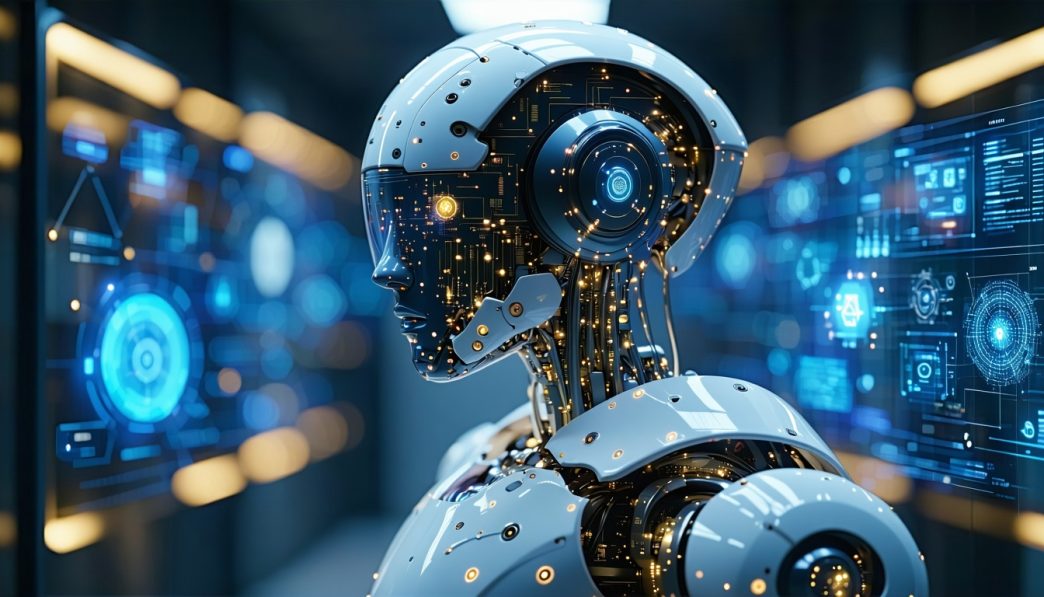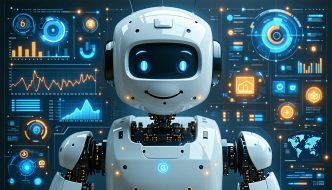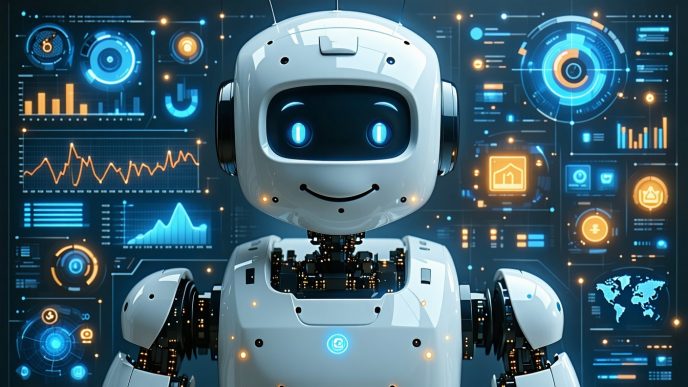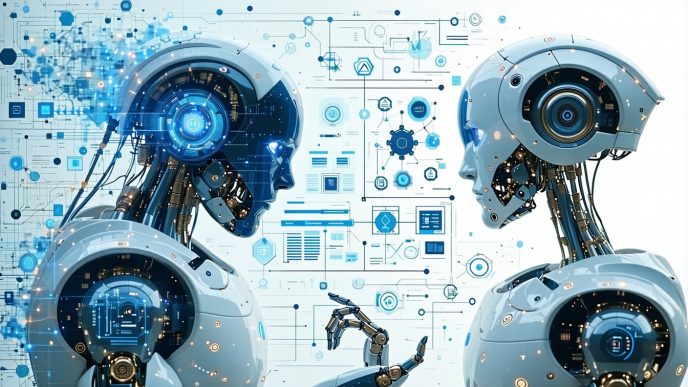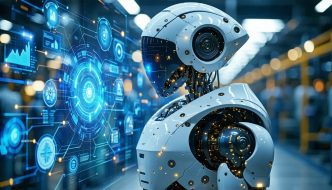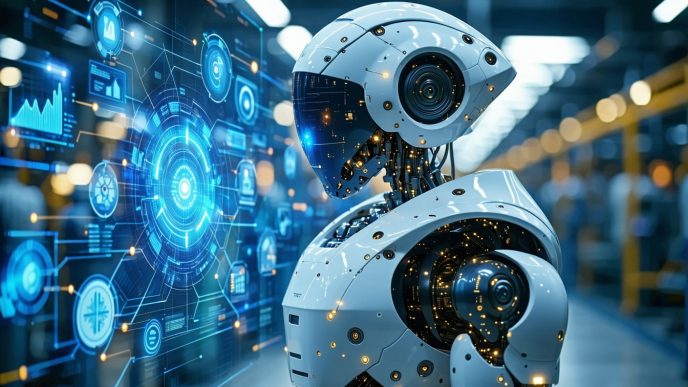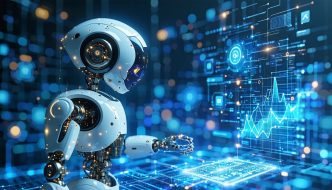Understanding AI Decision-Making in Robots
The field of robotics is rapidly evolving, transforming the way machines think and make decisions. To adequately trust these systems, it is essential to understand AI decision transparency in robots. This transparency is vital for users, as it helps them comprehend how robots arrive at their conclusions, especially in impactful situations.
Importance of Transparency in AI Decisions
Transparency in AI decision-making is crucial for various reasons. When users grasp how robots formulate decisions, they are more likely to trust and accept their actions. Key aspects of transparency include:
- Understanding Algorithms: Insight into the algorithms used by robots can demystify their decision processes and build user confidence.
- Accountability: With transparent decisions, it becomes easier to hold robots accountable for their actions. This is especially important in high-stakes scenarios such as healthcare or autonomous driving.
- Safety: Clear explanations about how decisions are made can improve safety by ensuring that users are aware of potential risks.
The following table summarizes key reasons for maintaining transparency in AI decision-making:
| Reason | Description |
|---|---|
| Understanding | Helps users know how robots reach conclusions |
| Accountability | Allows for assessment of robot decisions |
| Safety | Enhances awareness of potential risks and failures |
How Robots Make Impactful Choices
Robots utilize various processes and algorithms to make decisions that can have significant ramifications. Common methods used in AI decision-making include:
-
Machine Learning: This involves training algorithms on data to recognize patterns and make predictions. For instance, a robot might learn to navigate a room by analyzing previous movements and their outcomes. More insights can be found in our article on ai and decision making in robots.
-
Neural Networks: Mimicking the structure of the human brain, neural networks process information through interconnected nodes, enabling robots to understand complex data and make informed choices. Learn more about this technology through our article on robot learning models explained.
-
Real-Time Processing: In many cases, robots must make decisions swiftly. This capability is often powered by edge AI, allowing for quick data processing without relying heavily on cloud services. More details can be explored in our piece on real time ai processing in robots.
-
Multi-Agent Systems: Some robots operate as part of a team, collaborating to solve problems. In these situations, sharing information and making decisions collectively is crucial for efficiency. You can read about this in our article on multi agent ai in robotics.
By understanding these components, users can better appreciate how robots make impactful choices in various contexts.
Foundations of AI Decision-Making
Understanding the underlying technology that enables robots to make decisions is key to comprehending AI decision transparency in robots. Two significant components in this realm are machine learning algorithms and neural networks, which work together to facilitate intelligent decision-making processes.
Machine Learning Algorithms
Machine learning algorithms serve as the foundation for AI systems. These algorithms enable robots to analyze data, learn from it, and make decisions based on that acquired knowledge. The algorithms can be divided into different categories, each suited for various tasks and types of data.
| Algorithm Type | Description | Use Case |
|---|---|---|
| Supervised Learning | Learns from labeled data to make predictions | Image recognition |
| Unsupervised Learning | Identifies patterns in unlabeled data | Customer segmentation |
| Reinforcement Learning | Learns by trial and error, receiving rewards | Game playing |
Supervised learning is commonly used in scenarios where the outcome is known, allowing the robot to learn from examples. Unsupervised learning is beneficial for discovering inherent patterns in large datasets. Reinforcement learning enables robots to improve their decision-making over time through experience and feedback.
For more details on the application of these algorithms in AI, refer to our article on ai and decision making in robots.
Neural Networks and Deep Learning
Neural networks, particularly deep learning models, represent a significant advancement in AI decision-making. These networks consist of layers of interconnected nodes that mimic the way human brains operate. They are particularly effective for handling complex tasks such as image processing, speech recognition, and natural language processing.
| Neural Network Layer Type | Functionality | Example Use Case |
|---|---|---|
| Input Layer | Receives input data | Image pixels |
| Hidden Layers | Processes data through weights and biases | Feature extraction |
| Output Layer | Produces the final decision or prediction | Classifies images |
Deep learning enables robots to learn from vast amounts of unstructured data, allowing them to improve accuracy and decision capabilities. This type of network can adapt and refine its processes as it encounters new information, enabling real-time decision-making.
For insights into how deep learning impacts robotics, explore our article on large language models in robotics and real time ai processing in robots.
By understanding these foundational concepts, individuals can better appreciate how robots utilize complex algorithms and neural networks to make impactful decisions, highlighting the essence of AI decision transparency in modern robotics.
Unveiling the Black Box
Artificial intelligence in robots often operates within a so-called “black box,” meaning the processes and reasoning behind their decisions can be obscure. This opacity raises important questions about responsibility, trust, and accountability in AI systems.
The Challenge of AI Opacity
One of the main challenges of AI decision transparency in robots lies in the intricate algorithms and models that underpin their functioning. Frequently, these systems, especially those utilizing machine learning techniques, develop decision-making processes that even their creators may not fully understand. Factors contributing to this opacity include:
- Complex Algorithms: AI systems often depend on sophisticated algorithms that analyze vast amounts of data. This complexity makes it difficult to pinpoint why a robot made a particular decision.
- Data Bias: AI systems can inherit biases from the training data. If the data used is flawed or unrepresentative, the decisions made by the robots can reflect these issues, further complicating transparency.
- Lack of Standardization: There is currently no universal standard for explaining AI decisions across different platforms, leading to inconsistencies in how transparency is approached in various technologies.
Strategies for Improving Transparency
To counter the challenges associated with AI opacity, several strategies can be employed. These strategies aim to provide clearer insights into how robots reach their decisions and enhance trust in these systems:
| Strategy | Description |
|---|---|
| Explainable AI (XAI) | Focuses on creating models that provide understandable explanations for their decisions. This allows users to grasp the rationale behind AI outputs. |
| Model Audits | Regular assessments of AI decision-making processes can help identify biases and improve overall system integrity. |
| User-Centric Interfaces | Designing interfaces that allow users to query and explore the AI’s decision-making logic fosters a better understanding and trust. |
| Clear Documentation | Providing detailed documentation about algorithms, data handling, and potential biases can inform users and stakeholders about how decisions are made. |
By implementing these approaches, developers can enhance AI decision transparency in robots. Moreover, understanding the significance of ai and decision making in robots and actively working to facilitate transparency in these systems can help bolster public confidence in robotic technologies.
Human-Robot Interaction
Investigating human-robot interaction reveals essential ethical considerations and the importance of building trust with users. As robots are increasingly integrated into daily life and decision-making roles, understanding these aspects becomes crucial for effective and responsible technology deployment.
Ethical Considerations
Ethical implications arise when robots make impactful decisions that affect human lives. Questions about accountability, bias, and the morality of autonomous actions come into play. For instance, if a robot makes a decision leading to harm, determining who is responsible for that choice becomes complex. This complexity necessitates the implementation of ethical frameworks surrounding AI decision transparency in robots.
| Ethical Issue | Description |
|---|---|
| Accountability | Who is responsible for a robot’s decision? |
| Bias | How can algorithmic bias be mitigated? |
| Privacy | Are user data protections adequate? |
| Transparency | How understandable are a robot’s decisions? |
Addressing these issues requires continuous engagement from developers, ethicists, and users alike. AI systems must be designed with ethical considerations at their core to ensure fair and unbiased decision-making.
Building Trust with Users
Trust is essential for fostering positive human-robot interactions. Users must feel confident in a robot’s ability to make sound decisions based on transparent criteria. This trust can be cultivated through several practices, including:
- Open Communication: Providing clear explanations about how a robot arrives at its decisions. This aligns with the need for ai decision transparency in robots.
- User Feedback Mechanisms: Incorporating user feedback into AI algorithms to enhance performance and address concerns related to bias and performance.
- Consistent Performance: Ensuring robots perform reliably under various conditions, which can help establish a sense of reliability among users.
| Trust-Building Practice | Description |
|---|---|
| Open Communication | Explain decision-making processes transparently |
| User Feedback | Integrate users’ experiences and suggestions |
| Consistent Performance | Maintain a high level of reliability |
By focusing on ethical considerations and encouraging trust through communication and reliability, developers can enhance user engagement and promote a more positive relationship between humans and robots. Understanding these components will also better prepare users for the integration of AI in their lives, reinforcing the need for transparency in robotic decision-making.
Real-Time Decision-Making
Real-time decision-making is a vital aspect of robotic systems, especially when considering their role in various applications such as manufacturing, healthcare, and smart homes. This section focuses on the speed and accuracy of AI decisions and how robots balance predictability with flexibility.
Speed and Accuracy of AI Decisions
Robots equipped with artificial intelligence must make decisions quickly and accurately to perform their tasks effectively. The speed at which a robot can process information and produce a response is crucial. High-speed processing often relies on sophisticated algorithms that allow for the rapid analysis of data inputs.
The accuracy of these decisions is equally important. Errors in decision-making can have significant consequences, especially in critical scenarios like autonomous vehicles or medical robots. A balance between rapid response and precision is necessary for robots to function reliably.
To illustrate the relationship between speed and accuracy of AI decisions, the following table highlights typical response times and accuracy rates in various applications:
| Application | Average Response Time (ms) | Accuracy Rate (%) |
|---|---|---|
| Autonomous Vehicles | 50 | 95 |
| Industrial Robots | 100 | 98 |
| Healthcare Robots | 200 | 90 |
| Smart Home Devices | 30 | 85 |
Balancing Predictability and Flexibility
In addition to speed and accuracy, robots must find the right balance between predictability and flexibility. Predictable behavior is essential in environments where specific tasks must be completed reliably. For instance, in warehouse automation, a robot needs to consistently retrieve and store items without deviation.
Conversely, flexibility allows robots to adapt to unexpected situations, such as changes in their environment or unpredicted user interactions. This adaptability can enhance performance in dynamic settings, but it may introduce uncertainty in their operations.
Strategies to achieve this balance include:
- Dynamic Learning: Implementing machine learning algorithms that allow robots to refine their decision-making processes based on real-time feedback.
- Modular AI Systems: Using different modules for tasks that require either predictable routines or adaptive responses. For more insights into this, consider our article on ai and decision making in robots.
- Simulation Training: Testing robots in simulated environments to prepare them for real-world scenarios, enabling them to learn from a variety of situations.
Understanding these dynamics is essential for those interested in how robots operate and make decisions in real-time. This knowledge contributes to discussions on real-time ai processing in robots and the overall theme of ai decision transparency in robots.
Implications for Society
The rise of robots equipped with artificial intelligence (AI) has significant implications for society, especially regarding social and legal ramifications and the integration of AI in daily life.
Social and Legal Ramifications
As robots begin to make decisions that impact people’s lives, the need for clarity on how these decisions are made intensifies. This concern extends to issues like accountability and liability. If a robot makes a choice that leads to an unfortunate outcome, determining who is responsible—the AI developer, the user, or the robot itself—becomes complex.
Legal frameworks may need revision to address these challenges. Existing laws may not adequately cover scenarios involving AI decision-making. This gap could lead to challenges in holding parties accountable for the actions of AI-driven robots. Understanding AI decision transparency in robots will be crucial for shaping new regulations and societal norms.
| Aspect | Implication |
|---|---|
| Accountability | Who is liable for AI-generated decisions? |
| Legal Frameworks | Need for laws that address AI responsibility. |
| Public Trust | Transparency can help build trust in AI technologies. |
Integration of AI in Daily Life
AI’s integration into daily life offers numerous benefits and conveniences, from smart home devices that enhance security to robots that assist in healthcare settings. This technology allows users to manage tasks effortlessly and responsively. However, as AI systems increasingly become part of everyday tasks, understanding their decision-making process remains vital.
The seamless operation of AI in daily life warrants a focus on how these systems learn and adapt. Curiosity surrounding real-time AI processing in robots often leads to questions on effectiveness and reliability. Ensuring that users are educated about how AI functions enhances their ability to interact safely and effectively with these systems.
| Area | Example |
|---|---|
| Home Automation | Smart thermostats adjusting to user preferences. |
| Healthcare | Robots assisting in surgery with precision. |
| Transportation | Autonomous vehicles navigating complex environments. |
By addressing the social, legal, and integration aspects of AI decision-making, individuals can gain a comprehensive understanding of the landscape of AI in society. This awareness will prepare users to navigate the evolving world of robotics and AI technologies.
Future Trends in AI Decision Transparency
As technology progresses, the focus on AI decision transparency in robots continues to grow. This shift is driven by the need for clearer understanding and trust between humans and machines. Two significant trends currently shaping this landscape are advancements in explainable AI and the development of ethical guidelines and regulations.
Advancements in Explainable AI
Explainable AI (XAI) refers to methods and techniques that make the decision-making processes of AI systems more interpretable to humans. The goal of XAI is to bridge the knowledge gap between complex algorithms and the users who rely on them. By providing insights into how robots arrive at decisions, stakeholders can better grasp the implications of these choices.
Key advancements in XAI include:
| Advancement | Description |
|---|---|
| Model Transparency | Increased clarity about AI models allows users to understand how input data translates into decisions. |
| Visualization Tools | Graphical representations help users see how AI processes information and makes conclusions. |
| Feature Importance Metrics | These metrics highlight which factors influence AI decisions the most, providing insights into decision-making priorities. |
These advancements can improve user confidence and trust in robot functionality. For detailed information about the role of AI in decision-making, consider reading our article on ai and decision making in robots.
Ethical Guidelines and Regulations
With the proliferation of AI technologies, there is a growing demand for comprehensive ethical guidelines and regulations to govern their use. Governments, organizations, and industry groups are actively collaborating to develop standards that ensure responsible AI development and deployment. These guidelines focus on several key areas:
| Ethical Focus Area | Key Considerations |
|---|---|
| Accountability | Establishing clear ownership and responsibility for AI decisions. |
| Fairness | Ensuring unbiased AI processes that do not discriminate against any group. |
| Privacy | Protecting individuals’ data while enabling AI functionalities. |
| Transparency | Mandating that companies disclose how their algorithms work and make decisions. |
By implementing effective regulations, society can promote responsible AI use while addressing risks associated with autonomous systems. To explore more about how robots learn and make decisions, visit our article on robot learning models explained and stay informed about the intersection of technology and ethics.

